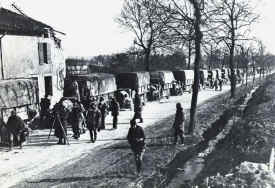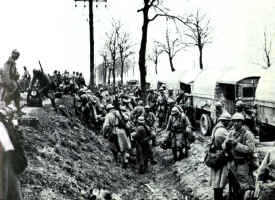| Back
to:
Phase 2 - The
German offensive on 21 Februari 1916
The Voie Sacrée (The Holy road) The supply and removal of people and the supply of food, materials and ammunition was of vital importance for the artillery power of the French army (ammunition in specific because the battle around Verdun became more and more a artillery battle (The Germans spoke of a material slaughter )). The Germans had a well operating railroad network available in their territory. The French connection between Verdun and the hinterland, on the other hand, existed only of a narrow railroad (called le Meusien) and a road of 75 kilometres long and 7 meters wide, which was in a bad state and lead to Bar-le-Duc, where the primary connection with the French railroad network was. This was the only connection with the hinterland: Verdun’s umbilical cord.
Pétain decided, just as with the battle at the Marne of 1914, to use
trucks for army supply. This was a revolutionary plan in those days
because the use of mechanical traction was still a rarity, on German side
as well. The entire route of the Voie Sacrée was divided into four zones.
From stone pits nearby, where German prisoners of war were put to work,
debris was supplied with which the holes in the roads were filled up
continuously. The massive truck tires were used as road rollers. Repair
workstations and towing expeditions were set up in the villages along the
road. Trucks that broke down were put aside without hesitation: nothing
could block Verdun’s life line. Already after a short period of time an
ongoing flow of all sorts of vehicles began, driving bumper to bumper.
Between the 24th of February and the 6th of march,
in 8 days time, 3500 trucks had already been brought in to bring 190.000
men and 23.000 ton of ammunition from Bar-le-Duc to Verdun. Calculations
were made that at the height of the battle a vehicle passed every 14
seconds (this is more than 250 vehicles an hour) and more than 12.000 cars
were available. Every week 50.000 ton of goods and 90.000 men were
transported along this road. At the battle of Verdun more than 2000.000
French soldiers and more than 1000.000 ton of ammunition (sometimes even
more than 2000.000 is mentioned) are transported to the front.
The French author Maurice Barrés later named the road Voie
Sacrée
because of its great importance in the Battle of Verdun. As a matter of
fact, the Voie Sacrée has never been bombarded by the Germans. Most likely
there is a tactical reason for this: to be able to realise the 'bleeding
to death' of the French army, there had to be a ongoing supply of fresh
troops and a bombardment would surely have put a stop to the supply. |

